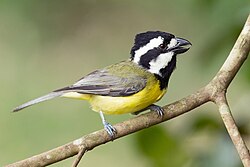| Falcunculus | |
|---|---|
 | |
| Eastern shriketit male | |
 | |
| Eastern shriketit female | |
| Scientific classification | |
| Kingdom: | Animalia |
| Phylum: | Chordata |
| Class: | Aves |
| Order: | Passeriformes |
| Superfamily: | Orioloidea |
| Family: | Falcunculidae |
| Genus: | Falcunculus Vieillot, 1816 |
| Type species | |
| Lanius frontatus [1] Latham, 1801 | |
| Species | |
See text | |
The shriketits are a group of three species of birds in the genus Falcunculus endemic to Australia where they inhabit open eucalypt forest and woodland.








